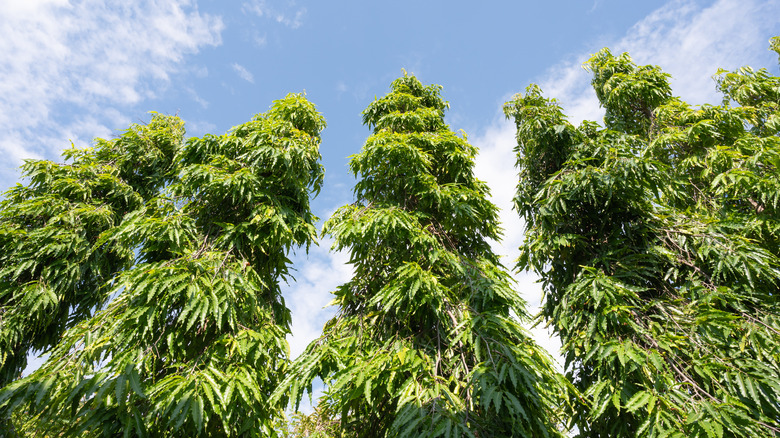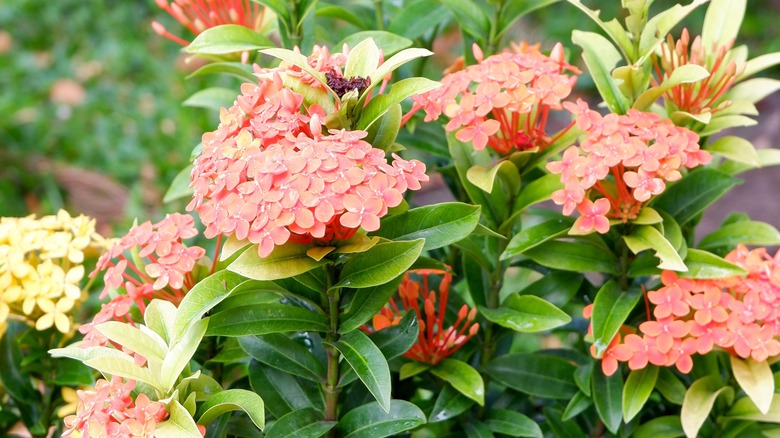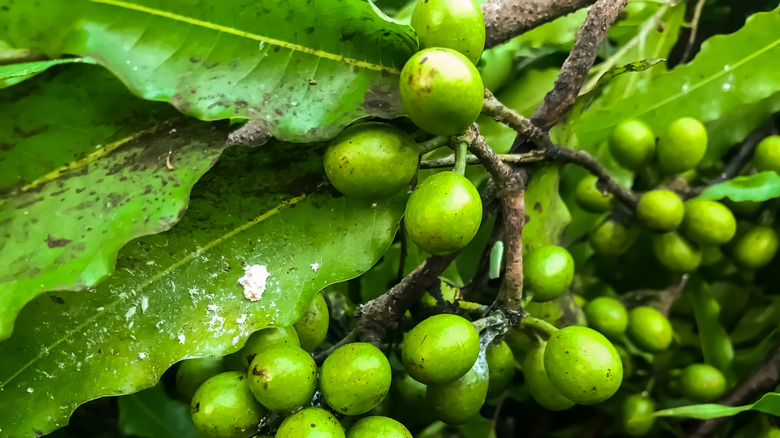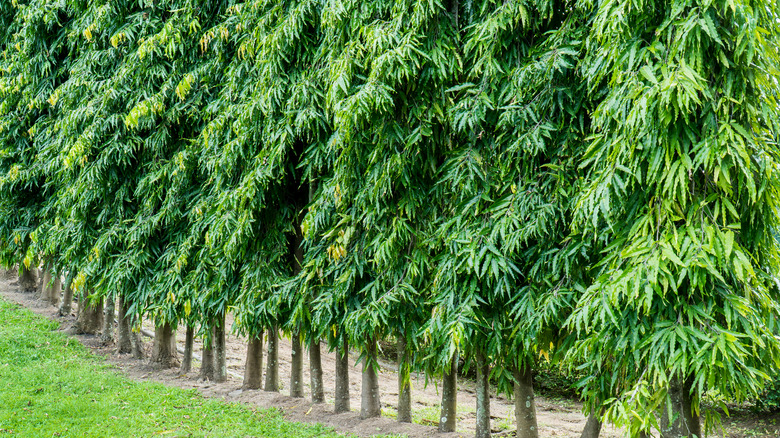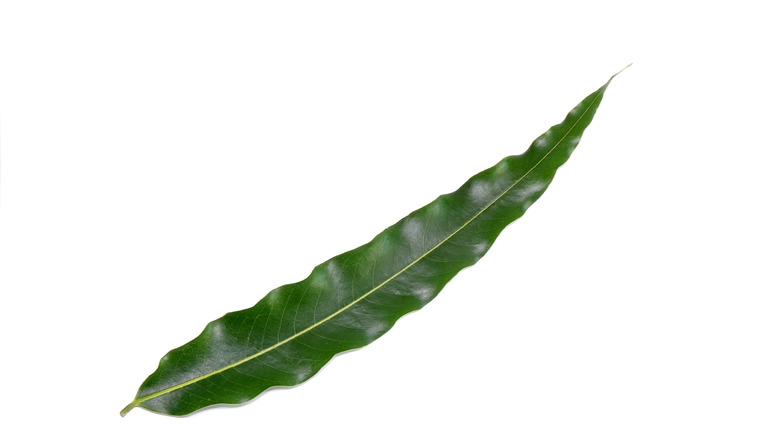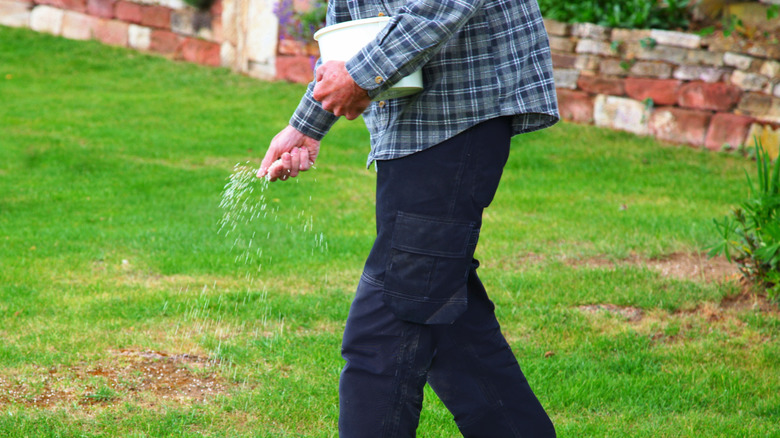How To Care For An Indian Tree
The Indian tree, also known as Indian mast, is a tall, beautiful evergreen tree that is native to India and other areas of South Asia. Also known as false ashoka, as well as its scientific name polyalthia longifolia, as provided by Palmco, the tree can grow as tall as 45 feet. This makes for a truly majestic sight, as the tree's leaves grow downward, creating the image of feathers.
As these trees are tall and slender, they are perfect to place in small narrow areas as they grow straight up, according to the South Florida Plant Guide. They further state when planted in a group, the wind tolerant Indian tree works well as a silencer reducing noise as well as providing privacy. They additionally state that one of the more unique features of this tree is that of the display of colorful leaves ranging from dark green to yellow and orange hues depending on age. The leaves remain on the tree year-round.
How to use Indian tree in the garden
There are many ways to use Indian mast trees in the garden. The towering trees make a perfect backdrop for an assortment of colorful flowers in any garden space or as stand-alone privacy greenery. They are also appealing when used to line driveways, private walking trails within a private garden, as well as create private spaces by being used as a divider, as suggested by Palmco. However you choose to use the Indian mast tree, it is an ideal choice to use due to its towering appearance, unique aesthetics, and feathery-looking leaves.
Another excellent suggestion is to use the trees in containers, allowing you to use them close to the home for concealing areas you may not want people to see. Should you use this option, place the container on bases with casters so they might easily be moved around from one place to another as needed, whether it's to give them more sun or to move them away from homes and fences as they grow bigger.
How to grow Indian tree
If you don't have an Indian mast tree but are interested in adding this unique tree to your landscape, you can easily propagate from seeds. According to Iplantz, you can expect to see germination within 14 to 21 days. They also state that seeds can be taken from the ripe fruit of a tree before birds get to it, should you have access, though you should clean them before planting in the soil.
If you opt for propagation over using seeds, you'll need to place your clipping it in water until you see roots, and handling it carefully, place it in the prepared pot of soil. You can also check local nurseries for small plants to start out on your quest for adding the plant to your landscape — which is by far the easiest route to take. The selection of the soil you use is paramount to the success of the growth of your tree. Always use well-draining soil, and be certain the pots you choose have drainage holes.
How to care for Indian tree
Though the Indian mast tree appears beautiful and strong, it still requires the proper care for it to reach its life expectancy. Caring for an Indian mast tree is not difficult, as stated by the South Florida Plant Guide. As the plant grows best in zones 10a to 11, which include states such as California. Being drought-tolerant, these areas are an ideal choice for hardiness and growth.
They further state these beauties don't require trimming due to the way the tree is shaped and the way the leaves fall, which is a great feature for the busy gardener. In terms of watering, their advice is regular irrigation of the plant. You do, however, want to ensure your plant is in soil that allows it to drain well to avoid pest and root diseases. You also want to water once weekly, according to the Bangalore Mirror. As far as fertilizing the Indian mast plant, the site suggests using a superior product for fertilizing.
The only season you will not fertilize the plant is in the winter months. Be prepared for spring to enjoy the beautiful star-shaped blooms as mentioned by Iplantz. You also want to ensure your tree has the space to grow as they require at least 5 feet, so allow be sure to have enough space between trees if you are planting more than one to avoid having to uproot the tree in the future by transplanting it.
Indian tree varieties
According to Iplantz, the most common variety of Indian trees is the pendula or polyalthia longifolia. It is tall and slender with short branches and has downward leaves that look like feathers. Another variety, considered less known, is angustifolia. The angustifolia has broad branches and a triangle shape appearance at the crown. The angustifolia has leaves that are sharp on the end and covers the trunk of the tree. The age of the tree determines the color of the leaves ranging in hues from green to yellow. The pendula, on the other hand, has short branches and shiny green leaves. Though there are only two varieties of Indian Mast trees yet cultivated, within the polyalthia Species, there are a couple of other trees similar.
- The Asoka Tree, also known as ashoka, and saraca asoka, gets its name from its barks' ability to provide medicinal healing to women, according to Lybrate.
- The ashok tree, saraca indica, or sorrow-less tree, according to Fundamatics, is tied into folklore that it will take away sorrows.
Is the Indian tree toxic?
Are Indian mast trees toxic to animals? As with all trees, care must be taken when having animals around plant life to ensure their safety and avoid the digestion of harmful substances. There is not just the roughness of bark, twigs, and stems that could possibly cause blockages and stomach upsets, but also the possibility that the plant itself may contain toxic chemicals that are harmful.
Taylor and Francis Online did a study on the toxicity of pendula leaf extract. Using Wistar albino rats as their test subjects, it was concluded that the methanol extract from the pendula leaf was, in fact, endured by the rats. They tested food and water intake, death and dying, changes to weight, and of course, toxicity, to name a few. The abstract further stated in the practice of Ayurveda that the leaf of this particular variety of Indian mast trees is used as a medicinal plant. Essentially saying the leaves are safe for consumption.
How to repot Indian tree
Indian mast trees are popular among container gardens and provide options for their use. If you started off propagating an Indian mast tree in a container and now have a plant and are in need of repotting, the task is quite simple. You want to ensure you use fresh soil with nutrients conducive to the growth and balance this species requires. It is also suggested to use a container that is at least twice the size of the original pot.
The ideal time to repot is when the tree is growing, so allow it more room to thrive. Before removing your tree from the original pot, have the new container ready so that you can easily move from one pot to the other one. Take care in handling the plant as it is important not to damage the roots during repotting. Gently place the tree in the newly prepared container with a scooped out area ready, and then pat around the base of the plant to secure it into the soil. Water until the flow of water is released from the drain hole of the container. Your Indian mast tree will require moderate watering. According to Iplantz, ensure your container is set in full sun or partial sun for the plant to thrive. Keep in mind container gardens require fertilization as plants in the earth tend to get nutrients from the soil.
How to use fertilizer with Indian tree
Fertilizer is key to providing nutrients to plants and trees. The same applies to hearty evergreens such as the Indian mast tree. Where nutrients come from the soil in which the trees are planted, the Indian mast tree requires fertilization in order to be healthy and to achieve maximum growth potential in the plant cycle. According to Urban Tropicals, it is suggested to select a fertilizer that is time-released. The recommended fertilizing schedule is three times a year, ideally scarcely, and approximately at a distance of about ten inches from the base.
They further state that trees that are not treated with fertilizer will grow at a slower rate. Additionally, Urban Tropics highly recommends staying away from cheaper fertilizer products due to heavy salts as these could damage the plant and possibly destroy it. If you are unsure of which product to select, ask for help from a specialist at a nursery to ensure the life of your tree.
